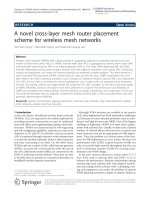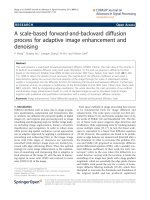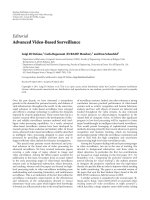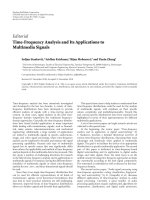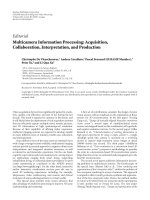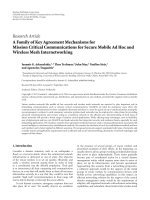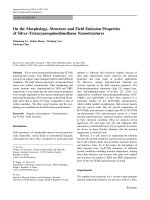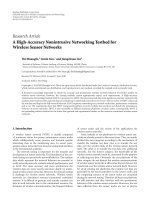Báo cáo hóa học: " Editorial Advanced Signal Processing and Computational Intelligence Techniques for Power Line Communications" pptx
Bạn đang xem bản rút gọn của tài liệu. Xem và tải ngay bản đầy đủ của tài liệu tại đây (1.15 MB, 3 trang )
Hindawi Publishing Corporation
EURASIP Journal on Advances in Signal Processing
Volume 2007, Article ID 45812, 3 pages
doi:10.1155/2007/45812
Editorial
Advanced Signal Processing and Computational Intelligence
Techniques for Power Line Communications
Mois
´
es Vidal Ribeiro,
1
Lutz Lampe,
2
Klaus Dostert,
3
and Halid Hrasnica
4
1
Department of Electrical Energy, Federal University of Juiz de Fora, 36 036 330 Juiz de fora, MG, Brazil
2
Department of Electrical and Computer Engineering, University of British Columbia, Canada V6T 124
3
University of Karlsruhe, 76131 Karlsruhe, Germany
4
Eurescom GmbH, 69123 Heidelberg, Germany
Received 1 July 2007; Accepted 1 July 2007
Copyright © 2007 Mois
´
es Vidal Ribeiro et al. This is an open access article distributed under the Creative Commons Attribution
License, which permits unrestricted use, distribution, and reproduction in any medium, provided the original work is properly
cited.
Power line communications (PLC) is defined as data com-
munication over power lines. The main reason to consider
the medium “power line” for communication purposes is the
extremely high penetration of the power distribution grid
in most parts of the world. From urban to remote rural ar-
eas, power supply lines reach practically every household and
thus are available as potential “carrier” of communication
signals. This argument extends to buildings (homes, busi-
nesses) and mobile entities such as automobiles, ships, air-
planes, or even spacecrafts, where electrical wiring enables
deployment of PLC systems for internal communication.
The concept of PLC is not new and has been applied by
power utilities for almost a century, mainly for sending con-
trol messages over medium and high voltage lines. In the late
1990s, with the deregulation of the telecommunication and
energy markets in Europe, power utilities became more se-
riously interested in providing additional services through
their lines. However, due to unrealistically high expectations
on PLC as “last-mile” solution for high-speed Internet ac-
cess, together with an unclear regulatory environment, lack
of standards, and underestimation of the technical difficul-
ties, the initial enthusiasm gave way to skepticism towards
the viability of PLC for fast Internet access.
Today, we witness a cautious optimism regarding the fu-
ture of PLC. This has several reasons. First, PLC is not only
a last-mile technology but much more. While broadband In-
ternet access over power lines remains an important appli-
cation and current wide-scale field trials indicate commer-
cial viability, power utilities, PLC vendors, and academic re-
searchers are working together closely to unleash the full
potential of PLC for efficient distribution-grid management
and monitoring. Home networking is another major applica-
tion for PLC and various consumer electronics giants are par-
ticipating in the sophistication and standardization of PLC
technology. Deployments of command-and-control PLC sys-
tems are expanding beyond classical home automation to,
for example, lighting control in industrial premises and air-
fields, and other markets such as PLC for in-vehicle com-
munication are currently explored. Second, the potentials of
PLC are looked upon more realistically and the challenges
of PLC are better understood. This concerns, for example,
the differences in electrical wiring in different parts of the
world and the characteristics of the power line as medium for
data communication. Third, standardization for PLC is un-
derway, driven, for example, by ETSIs Technical Committee
on Power-Line Telecommunications and three IEEE work-
ing groups. Last but not least, there is a growing commu-
nity of academic and industry researchers with backgrounds
in various disciplines (signal processing, power engineering,
electromagnetics, etc.), who are working on intelligent PLC
solutions to enable the applications mentioned above. This
special issue is evidence of this trend.
From a communications-engineering point of view, the
most salient feature of PLC is the “hostile” channel. Differ-
ent from other wired media, power lines were not designed
for carrying broadband electromagnetic waves used for data
transmission. The communication channel is characterized
by high-path loss, severe frequency selectivity, and compos-
ite additive noise which includes impulse, narrowband, and
colored background noise components. Furthermore, short-
term (synchronous with the mains) a nd long-term channel
variations occur.
This special issue contains seven papers, selected from
27 submitted papers, which are dedicated to advanced signal
2 EURASIP Journal on Advances in Signal Processing
processing techniques to cope with such a harsh transmission
environment.
In the first paper entitled “Wideband impulse modula-
tion and receiver algorithms for multiuser power line com-
munications,” A. Tonello proposes a wide-band impulse-
based code-division multiple access (CDMA) transmission
system for multiuser indoor PLC. The large signal bandwidth
allows to exploit frequency diversity and make the system ro-
bust to narrowband interference. Robustness against impulse
noise is achieved due to error correcting coding and CDMA
spreading. These favorable features come at the price of in-
creased detection complexity. Therefore, the author presents
suboptimal frequency-domain receiver algorithms with re-
duced complexity, which render the proposed impulse-based
modulation scheme an interesting alternative for PLC.
R. Pighi and R. Raheli present powerful sequence detec-
tors for coded single-carrier PLC in their paper “Linear pre-
dictive detection for power line communications impaired by
colored noise.” The effect of quasistationary colored noise on
low- and high-voltage lines is explicitly taken into account
in the joint equalizer-decoder design, and optimal and sim-
plified receiver front ends and branch metrics for (reduced-
stated) sequence detection are derived. The potential perfor-
mance improvements due to receiver adaptation to colored
noise are theoretically analyzed and confirmed by bit-error
rate simulations.
The next pap er is “Resource allocation with adaptive
spread spectrum OFDM using 2D spreading for power-line
communications” by J Y. Baudais and M. Crussi
`
ere. Simi-
lar to telephone or wireless communication systems, multi-
carrier modulation is a very popular approach to deal with
the frequency selectivity of the channel also for PLC. As-
suming a quasistatic power line channel, the authors pro-
pose loading algorithms for spread spectrum orthogonal fre-
quency division multiplexing (OFDM) with the distinct fea-
ture that spreading is done in time and in frequency direction
(2D spreading). This additional degree of freedom compared
to 1D spreading allows finer adaptation of the transmission
parameters to the channel realization. The presented algo-
rithms perform subcarrier, spreading-code, bit and energy
allocation, and are shown to improve the data rate over non-
spread loaded systems for fixed error-rate performance.
The fourth and fifth papers deal with synchronization for
PLC multicarrier systems taking the particularities of PLC
channels into account.
J. A. Cort
´
es et al. investigate in “Analysis and design
of timing recovery schemes for DMT systems over indoor
power-line channels” the effect of short-term channel vari-
ations on the sampling-time synchronization in multicar-
rier systems. Short-term variations originate from the depen-
dence of device impedances on the main voltage and thus are
cyclic in nature. It is argued that short-term channel varia-
tions mislead conventional closed-loop timing synchroniza-
tion schemes for multicarrier modulation unless the loop
bandwidth is sufficiently small, which in turn makes them
sensitive to jitter noise. To better cope with the cyclic channel
variations, the authors propose two modifications, namely,
the introduction of notch filters to the timing loop and an
improved phase estimator. Numerical results using 24 mea-
sured channels show that data rate can be significantly in-
creased with the modified timing synchronization.
While the previous paper considered high data-rate PLC
transmission for, for example, in-home entertainment sys-
tems, the paper “Fast burst synchronization for power line
communication systems” by G. Bumiller and L. Lampe is
concerned with synchronization in low data-rate distributed
PLC systems employed in, for example, command-and-
control and power-grid management systems. The authors
submit that in order to achieve reliable synchronization of
asynchronously transmitted OFDM packets (or bursts) in
a PLC setting with as little overhead as possible, conven-
tional preamble signals are not well suited. Instead, a new
semianalytic framework for preamble design taking into ac-
count the particularities of the power line channel is devel-
oped. An extensive performance comparison between an ex-
emplary preamble design and two conventional synchroniza-
tion preambles makes the advantages of the proposed frame-
work explicit.
The final two papers are dedicated to the problem of
error-correcting coding for PLC systems. More specifically,
the use and optimization of the recently rediscovered low-
density parity-check (LDPC) codes are investigated.
In the paper “Improving a power line communications
standard with LDPC codes” C. Hsu et al. consider the ap-
plication of LDPC codes to the robust-OFDM (ROBO)
mode of the Homeplug 1.0 standard, which provides mod-
est throughput in worst-case transmission scenarios. While
the current standard prescribes the concatenation of Reed-
Solomon and convolutional codes, the authors show that re-
placing this scheme with LDPC codes results in throughput,
reliability, and complexity improvements. Key ingredient is a
clipping procedure devised by the authors to reduce the dis-
torting effect of impulse noise on decoding metrics.
A. Sanaei and M. Ardakani authored the last paper
“LDPC code design for nonuniform power-line channels,”
which presents a coding scheme for multicarrier modula-
tion that allows for using a single LDPC code over the, in
frequency direction, nonuniform channel. Instead of consid-
ering bit-loading, the nonuniformity of the channel quality is
dealt with in the code design. More specifically, the frequency
subchannels are grouped (into a small number of groups) ac-
cording to the signal-to-noise ratio, and different LDPC de-
gree distributions are used for bits assigned to subchannels in
each group. The code optimization is formulated as an itera-
tive linear program, which can be efficiently solved. Applied
to typical indoor power line channels, it is possible to closely
approach capacity with this design.
We believe that the collection of papers in this special is-
sue illustrates the great variety of topics (and problems) in
PLC for which tools from advanced signal processing are ap-
plicable and needed. Perhaps, the reader will also have no-
ticed that in most contributions the system model does not
include
all
of the characteristics of power line channels men-
tioned earlier. While this is often justified due to different
impacts on performance depending on the application sce-
nario in mind, it also alludes to the fact that propagation and
Mois
´
es Vidal Ribeiro et al. 3
channel modeling for PLC is still a very active field of research
and that standard models are not available yet. Similar is true
for models of unintentional radiation, which is an extremely
important topic regarding electromagnetic compatibility of
PLC. Hence, fur ther research on advanced signal processing
techniques for PLC, carried out in tandem with the refine-
ment and standardization of channel and radiation models,
is called for. We hope that this special issue encourages and
stimulates many colleagues to contribute to this effort.
Finally, we would like to take this oppor tunity to express
our thanks to all authors who have submitted contributions
to this special issue and to our colleagues who devoted their
valuable time reviewing these submissions.
Mois
´
es Vidal Ribeiro
Lutz Lampe
Klaus Dostert
Halid Hrasnica
Mois
´
es Vidal Ribeiro received the B.S. de-
gree in electrical engineering from the Fed-
eral University of Juiz de Fora (UFJF), Juiz
de Fora, Brazil, in 1999, and the M.S. and
Ph.D. degrees in electrical engineering from
the University of Campinas (UNICAMP),
Campinas, Brazil, in 2001 and 2005, respec-
tively. Currently, he is an Assistant Professor
at UFJF. He was a Visiting Researcher in the
ISPL of the University of California, Santa
Barbara, in 2004, a postdoctor at UNICAMP, in 2005, and at UFJF
from 2005 to 2006. He is the Guest Editor of EURASIP Journal
on Advances in Signal Processing for the Special Issue on Emerg-
ing Signal Processing Techniques for Power Quality Applications.
He has authored over 60 journal and conference papers, one book
chapter, and holds six patents. His research interests include com-
putational intelligence, signal processing, power quality, power line
communication, and digital communications. He received student
awards from IECON’01 and ISIE ’03. He is a Member of the TPC of
the ISPLC ’06, ISPLC ’07, Globecom ’07, CERMA ’06, CERMA ’07,
and ANDESCOM ’06, Chair of the 2007 Workshop about PLC in
Brazil, and a Member of the IEEE ComSoc TC on Power Line Com-
munications. He is a Member of the IEEE.
Lutz Lampe received the Diploma and the
Ph.D. degrees in electrical engineering from
the University of E rlangen, Germany, in
1998 and 2002, respectively. Since 2003, he
has been with the Department of Electrical
and Computer Engineering at the Univer-
sity of British Columbia, where he is cur-
rently an Associate Professor. His main re-
search interests lie in the areas of commu-
nications and information theory applied
to wireless and power line transmission. He is corecipient of the
EURASIP Signal Processing Journal Best Paper Award 2005, the
Best Paper Award at the IEEE International Conference on Ultra-
Wideband (ICUWB) 2006, and the Best Student Paper Awards at
the European Wireless Conference 2000 and at the International
Zurich Seminar 2002. In 2003, he received the Dissertation Award
of the German Society of Information Techniques (ITG). He is an
Editor for the IEEE Transactions on Wireless Communications and
has served as an Associate Editor for the IEEE Transactions on Ve-
hicular Technology from 2004 to 2007. Since 2004, he has been Vice
Chair of the IEEE Communications Society Technical Committee
on Power Line Communications. He was General Chair of the 2005
International Symposium on Power Line Communications and Its
Applications (2005 ISPLC), Cochair of the General Symposium
of the 2006 IEEE Global Telecommunications Conference (Globe-
com 2006), and Technical Program Committee Cochair of the 2007
IEEE ISPLC.
Klaus Dostert received his M.S. degree
from RWTH Aachen, Germany, in 1976,
and the Ph.D. degree from the University of
Kaiserslautern in 1980. During the follow-
ing years, he worked as a postdoctoral fel-
low in the fields of RF communications, sig-
nal processing, and data transmission over
power lines. In 1991, he completed his ha-
bilitation dissertation on RF communica-
tions, and became a Full Professor at the
University of Karlsruhe in 1992. During the past 15 years, his work
centered around various aspects of PLC, including channel emu-
lation, system desig n, and EMC analysis. Dr. Dostert is an IEEE
Senior Member and has published more than 120 scientific papers
and two books on power line communications. In 2000, he was a
guest lecturer at the Technical University of Vienna. For the time
period 2007-2008, he has been selected as a ComSoc Distinguished
Lecturer.
Halid Hrasnica graduated in 1993 in elec-
trical engineering at the University of Sara-
jevo, Bosnia and Herzegovina. From 1993
to 1995, he was working in Energoinvest
Communications in Sarajevo as develop-
ing software Engineer for communications
systems. In 1995 he joined the Chair for
Telecommunications at Dresden University
of Technology, Germany, where he received
his Ph.D. degree in electrical engineering
and information technology in May 2004.
In February 2006, he joined Eurescom GmbH in Heidelberg, Ger-
many, where he works as Programme Manager responsible for
projects on future telecommunications networks. His main areas of
expertise include the design of communications protocols, devel-
opment of routing algorithms, performance evaluation of broad-
band communications networks, network planning and optimiza-
tion. He published a large number of scientific papers and is Mem-
ber of IEEE Technical Committee Powerline Communications and
is TPC Member for IEEE International Conference on Communi-
cations, GLOBECOM, ISPLC, AccessNets2007, and SPIE’s ITCom
conference. He is the main author of the book Broadband Powerline
Communications, published by Wiley and Sons in 2004, and main
contributor to Wiley Encyclopedia of Telecommunications 2002,
on the same topic. He was involved as researcher and project man-
ager in several national and international R&D projects in various
frameworks as well as industry projects.
